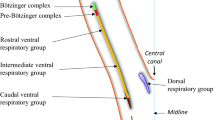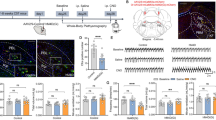Abstract
Dexmedetomidine, an α2-adrenoceptor agonist, has been approved for clinical use, although the mechanism of dexmedetomidine action has not been fully elucidated. Several studies have shown that G protein-coupled receptors (GPCRs) are recognized as targets for anesthetics and analgesics. Therefore, it is of interest to determine whether dexmedetomidine affects the function of GPCRs other than the α2-adrenoceptor. We examined the effects of dexmedetomidine on M1, M3, 5-HT2C, substance P, and orexin 1 receptors in Xenopus oocytes expressing individual receptors. In addition, we investigated the effects of dexmedetomidine on muscarinic receptor-mediated changes in [Ca2+]i in the dorsal root ganglia (DRG) of 3-week-old Wister rats. Dexmedetomidine did not affect the 5-HT2C-, or substance P-induced Cl− currents and had little inhibition on the orexin A-induced current in oocytes expressing the respective receptors. The compound also had little effect on the acetylcholine (ACh, 1 μM)-induced Ca2+-activated Cl− currents in Xenopus oocytes expressing M1 receptors. In contrast, dexmedetomidine inhibited the ACh-induced currents in Xenopus oocytes expressing M3 receptors; 1 nM, 10 nM, 100 nM, and 1 μM dexmedetomidine reduced the current to 66.5 ± 4.8, 51.3 ± 12, 34.6 ± 11, and 26.8 ± 6.4% of the control value, respectively (EC50 = 3.5 ± 0.7 nM). Dexmedetomidine reduced the ACh-induced Cl− currents after treatment with the selective protein kinase C inhibitor GF109203X. Moreover, the compound inhibited the muscarinic receptor-mediated increases in [Ca2+]i in cultured DRG cells in a concentration-dependent manner. Dexmedetomidine inhibits the function of M3 receptors, in addition to its agonistic effects on α2-adrenoceptors, which provides further insight into the pharmacological properties of dexmedetomidine.





Similar content being viewed by others
References
Bernardini N, Levey AI, Augusti-Tocco G (1999) Rat dorsal root ganglia express m1–m4 muscarinic receptor proteins. J Peripher Nerv Syst 4:222–232
Caulfield MP (1993) Muscarinic receptors—characterization, coupling and function. Pharmacol Ther 58:319–379
Chapman V, Dickenson AH (1993) The effect of intrathecal administration of RP67580, a potent neurokinin 1 antagonist on nociceptive transmission in the rat spinal cord. Neurosci Lett 157:149–152
Coggeshall RE, Carlton SM (1997) Receptor localization in the mammalian dorsal horn and primary afferent neurons. Brain Res Brain Res Rev 24:28–66
De Koninck Y, Henry JL (1991) Substance P-mediated slow excitatory postsynaptic potential elicited in dorsal horn neurons in vivo by noxious stimulation. Proc Natl Acad Sci USA 88:11344–11348
Do SH, Kamatchi GL, Durieux ME (2001) The effects of isoflurane on native and chimeric muscarinic acetylcholine receptors: the role of protein kinase C. Anesth Analg 93:375–381
Durieux ME (1996) Muscarinic signaling in the central nervous system. Recent developments and anesthetic implications. Anesthesiology 84:173–189
Dyck JB, Maze M, Haack C, Azarnoff DL, Vuorilehto L, Shafer SL (1993a) Computer-controlled infusion of intravenous dexmedetomidine hydrochloride in adult human volunteers. Anesthesiology 78:821–828
Dyck JB, Maze M, Haack C, Vuorilehto L, Shafer SL (1993b) The pharmacokinetics and hemodynamic effects of intravenous and intramuscular dexmedetomidine hydrochloride in adult human volunteers. Anesthesiology 78:813–820
Fibiger HC (1991) Cholinergic mechanisms in learning, memory and dementia: a review of recent evidence. Trends Neurosci 14:220–223
Franks NP, Lieb WR (1994) Molecular and cellular mechanisms of general anaesthesia. Nature 367:607–614
Gertler R, Brown HC, Mitchell DH, Silvius EN (2001) Dexmedetomidine: a novel sedative–analgesic agent. Proc (Bayl Univ Med Cent) 14:13–21
Gyermek L (1996) Pharmacology of serotonin as related to anesthesia. J Clin Anesth 8:402–425
Haberberger R, Scholz R, Kummer W, Kress M (2000) M2-receptor subtype does not mediate muscarine-induced increases in [Ca(2+)](i) in nociceptive neurons of rat dorsal root ganglia. J Neurophysiol 84:1934–1941
Harris RA, Mihic SJ, Dildy-Mayfield JE, Machu TK (1995) Actions of anesthetics on ligand-gated ion channels: role of receptor subunit composition. FASEB J 9:1454–1462
Hervieu GJ, Cluderay JE, Harrison DC, Roberts JC, Leslie RA (2001) Gene expression and protein distribution of the orexin-1 receptor in the rat brain and spinal cord. Neuroscience 103:777–797
Holzer P, Maggi CA (1998) Dissociation of dorsal root ganglion neurons into afferent and efferent-like neurons. Neuroscience 86:389–398
Honda K, Harada A, Takano Y, Kamiya H (2000) Involvement of M3 muscarinic receptors of the spinal cord in formalin-induced nociception in mice. Brain Res 859:38–44
Horishita T, Minami K, Uezono Y, Shiraishi M, Ogata J, Okamoto T, Terada T, Sata T (2005) The effects of the neurosteroids: pregnenolone, progesterone and dehydroepiandrosterone on muscarinic receptor-induced responses in Xenopus oocytes expressing M1 and M3 receptors. Naunyn Schmiedebergs Arch Pharmacol 371:221–228
Hu HZ, Li ZW, Si JQ (1997) Evidence for the existence of substance P autoreceptor in the membrane of rat dorsal root ganglion neurons. Neuroscience 77:535–541
Jorm CM, Stamford JA (1993) Actions of the hypnotic anaesthetic, dexmedetomidine, on noradrenaline release and cell firing in rat locus coeruleus slices. Br J Anaesth 71:447–449
Kroeze WK, Kristiansen K, Roth BL (2002) Molecular biology of serotonin receptors structure and function at the molecular level. Curr Top Med Chem 2:507–528
Meller ST, Lewis SJ, Brody MJ, Gebhart GF (1991) The peripheral nociceptive actions of intravenously administered 5-HT in the rat require dual activation of both 5-HT2 and 5-HT3 receptor subtypes. Brain Res 561:61–68
Minami K, Uezono Y (2006) Gq protein-coupled receptors as targets for anesthetics. Curr Pharm Des 12:1931–1937
Minami K, Yanagihara N, Toyohira Y, Tsutsui M, Shigematsu A, Wada A, Izumi F (1994) Isoflurane inhibits nicotinic acetylcholine receptor-mediated 22Na+ influx and muscarinic receptor-evoked cyclic GMP production in cultured bovine adrenal medullary cells. Naunyn Schmiedebergs Arch Pharmacol 349:223–229
Minami K, Minami M, Harris RA (1997a) Inhibition of 5-hydroxytryptamine type 2A receptor-induced currents by n-alcohols and anesthetics. J Pharmacol Exp Ther 281:1136–1143
Minami K, Vanderah TW, Minami M, Harris RA (1997b) Inhibitory effects of anesthetics and ethanol on muscarinic receptors expressed in Xenopus oocytes. Eur J Pharmacol 339:237–244
Minami K, Gereau RWIV, Minami M, Heinemann SF, Harris RA (1998) Effects of ethanol and anesthetics on type 1 and 5 metabotropic glutamate receptors expressed in Xenopus laevis oocytes. Mol Pharmacol 53:148–156
Minami K, Shiraishi M, Uezono Y, Ueno S, Shigematsu A (2002) The inhibitory effects of anesthetics and ethanol on substance P receptors expressed in Xenopus oocytes. Anesth Analg 94:79–83
Minami K, Uezono Y, Sakurai T, Horishita T, Shiraishi M, Ueta Y (2007) The effects of anesthetics on the function of orexin-1 receptors expressed in Xenopus oocytes. Pharmacology 79:236–242
Naguib M, Yaksh TL (1997) Characterization of muscarinic receptor subtypes that mediate antinociception in the rat spinal cord. Anesth Analg 85:847–853
Nakamura M, Minami K, Uezono Y, Horishita T, Ogata J, Shiraishi M, Okamoto T, Terada T, Sata T (2005) The effects of the tramadol metabolite O-desmethyl tramadol on muscarinic receptor-induced responses in Xenopus oocytes expressing cloned M1 or M3 receptors. Anesth Analg 101:180–186
Ogata J, Minami K, Uezono Y, Okamoto T, Shiraishi M, Shigematsu A, Ueta Y (2004) The inhibitory effects of tramadol on 5-hydroxytryptamine type 2C receptors expressed in Xenopus oocytes. Anesth Analg 98:1401–1406
Okamoto T, Minami K, Uezono Y, Ogata J, Shiraishi M, Shigematsu A, Ueta Y (2003) The inhibitory effects of ketamine and pentobarbital on substance p receptors expressed in Xenopus oocytes. Anesth Analg 97:104–110
Saper CB, Chou TC, Scammell TE (2001) The sleep switch: hypothalamic control of sleep and wakefulness. Trends Neurosci 24:726–731
Shibuya I, Tanaka K, Hattori Y, Uezono Y, Harayama N, Noguchi J, Ueta Y, Izumi F, Yamashita H (1999) Evidence that multiple P2X purinoceptors are functionally expressed in rat supraoptic neurones. J Physiol 514:351–367
Shiga Y, Minami K, Shiraishi M, Uezono Y, Murasaki O, Kaibara M, Shigematsu A (2002) The inhibitory effects of tramadol on muscarinic receptor-induced responses in Xenopus oocytes expressing cloned M(3) receptors. Anesth Analg 95:1269–1273
Shiraishi M, Minami K, Uezono Y, Yanagihara N, Shigematsu A (2001) Inhibition by tramadol of muscarinic receptor-induced responses in cultured adrenal medullary cells and in Xenopus laevis oocytes expressing cloned M1 receptors. J Pharmacol Exp Ther 299:255–260
Shiraishi M, Shibuya I, Minami K, Uezono Y, Okamoto T, Yanagihara N, Ueno S, Ueta Y, Shigematsu A (2002) A neurosteroid anesthetic, alphaxalone, inhibits nicotinic acetylcholine receptors in cultured bovine adrenal chromaffin cells. Anesth Analg 95:900–906
Shiraishi M, Minami K, Shibuya I, Uezono Y, Ogata J, Okamoto T, Murasaki O, Kaibara M, Ueta Y, Shigematsu A (2003) The inhibitory effects of alphaxalone on M1 and M3 muscarinic receptors expressed in Xenopus oocytes. Anesth Analg 97:449–455
Tata AM, Tripiciano A, Filippini A, Biagioni S, Augusti-Tocco G (2000a) Muscarinic receptors modulate intracellular calcium level in chick sensory neurons. Brain Res 866:65–72
Tata AM, Vilaro MT, Mengod G (2000b) Muscarinic receptor subtypes expression in rat and chick dorsal root ganglia. Brain Res Mol Brain Res 82:1–10
Todorovic S, Anderson EG (1990a) 5-HT2 and 5-HT3 receptors mediate two distinct depolarizing responses in rat dorsal root ganglion neurons. Brain Res 511:71–79
Todorovic SM, Anderson EG (1990b) Pharmacological characterization of 5-hydroxytryptamine 2 and 5-hydroxytryptamine 3 receptors in rat dorsal root ganglion cells. J Pharmacol Exp Ther 254:109–115
Toullec D, Pianetti P, Coste H, Bellevergue P, Grand-Perret T, Ajakane M, Baudet V, Boissin P, Boursier E, Loriolle F, Duhamel L, Charon D, Kirilovsky J (1991) The bisindolylmaleimide GF 109203X is a potent and selective inhibitor of protein kinase C. J Biol Chem 266:15771–15781
Wess J (1996) Molecular biology of muscarinic acetylcholine receptors. Crit Rev Neurobiol 10:69–99
Willis WD Jr (1999) Dorsal root potentials and dorsal root reflexes: a double-edged sword. Exp Brain Res 124:395–421
Xu XJ, Wiesenfeld-Hallin Z (1992) Intrathecal neurokinin A facilitates the spinal nociceptive flexor reflex evoked by thermal and mechanical stimuli and synergistically interacts with substance P. Acta Physiol Scand 144:163–168
Zornow MH, Maze M, Dyck JB, Shafer SL (1993) Dexmedetomidine decreases cerebral blood flow velocity in humans. J Cereb Blood Flow Metab 13:350–353
Zucker J (1991) Central cholinergic depression reduces MAC for isoflurane in rats. Anesth Analg 72:790–795
Author information
Authors and Affiliations
Corresponding author
Rights and permissions
About this article
Cite this article
Takizuka, A., Minami, K., Uezono, Y. et al. Dexmedetomidine inhibits muscarinic type 3 receptors expressed in Xenopus oocytes and muscarine-induced intracellular Ca2+ elevation in cultured rat dorsal root ganglia cells. Naunyn-Schmied Arch Pharmacol 375, 293–301 (2007). https://doi.org/10.1007/s00210-007-0168-4
Received:
Accepted:
Published:
Issue Date:
DOI: https://doi.org/10.1007/s00210-007-0168-4




